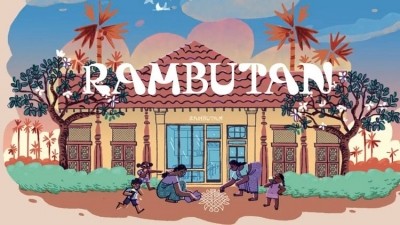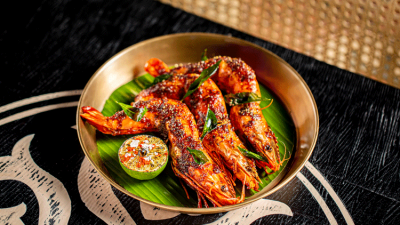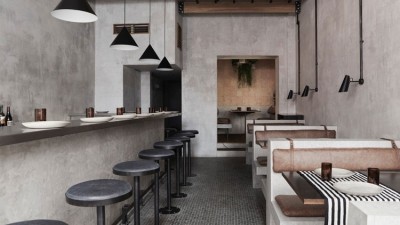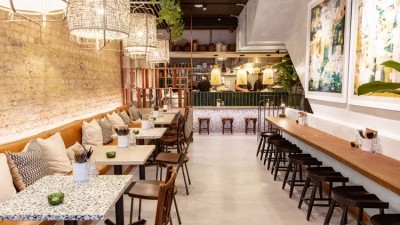Cynthia Shanmugalingam: “I want Rambutan to be an expression of joy”
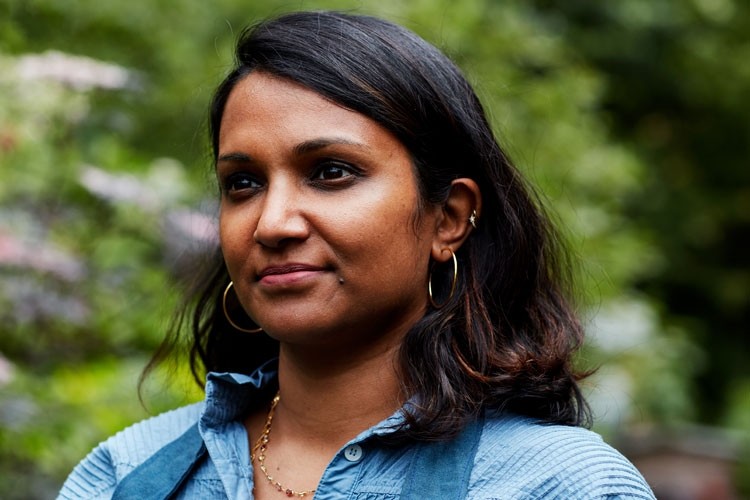
Most chefs wait until after they’ve opened their restaurant before releasing an accompanying cookbook, but for Cynthia Shanmugalingam a fortuitous turn of events meant she found herself writing about the venture she wanted to open before she even had a site for it. “Doing a cookbook was never really part of the plan,” she says, reflectively. “That came out of Covid and not being able to open the restaurant when I wanted.”
Before the pandemic, Shanmugalingam did have a site where she hoped to open Rambutan – the diaspora Sri Lankan restaurant concept she’d been developing since around 2018 – in London’s Shoreditch, but the deal fell through when the first national lockdown hit (the Curtain Road site eventually opened as Manteca in late 2021). “After that I began thinking about giving up and finding a new job, but then a friend suggested I do a cookbook version of the restaurant,” she continues. “It helped keep Rambutan alive in my head while I considered my next move.”
Fast forward a few years, and the chef is finally opening the doors to her first permanent restaurant site. Located on Stoney Street, moments from Borough Market, the launch of Rambutan signals the culmination of a story that begun when she was a child. “My parents came to the UK from Sri Lanka in the late sixties, and I was born in Coventry in the eighties. And I’ve been going back and forth to the country since I was a baby.”
Shanmugalingam’s parents hailed from the Northern Province of Sri Lanka, but for much of her life she was only able to visit the south of the country because of the civil war, which begun in 1983 and spanned 26 years.
“It wasn’t until 2009 that I could go home for the first time with my mum and dad and could see how they cooked in the villages. My parents are from a very rural part of Sri Lanka. Everyone cooks on fire using locally sourced ingredients. It’s quite an undertaking, and it showed me that when you can get fresh meat and vegetables and freshly milled spices that’s cooked over fire, Sri Lankan food is so exciting. And I didn’t think there was anywhere in London that was representative of that style of cooking.”
Plans for Rambutan were first announced in June 2022 with a view to opening the restaurant in October. But the impact of rising cost pressures and shipping delays caused by Covid restrictions in China meant that the restaurant only launched late last month. “It’s a huge relief to be opening,” she adds.
“It feels like we’ve had to overcome an armageddon of different factors. It’s really challenging to open a restaurant right now, but it does also feel like the sector has a newfound optimism that wasn’t there a few months ago. Borough is buoyant, and it feels like a good time to be launching.”
An ‘expression of joy’
We’re sat in Rambutan on the morning of what will be the restaurant’s first full service. Around us, workmen are rushing about putting the finishing touches to the dining room. At regular intervals, Shanmugalingam has to pause the interview to either greet new employees as they arrive or answer operational questions from the general manager.
The restaurant’s design combines elements of the mid-20th century architectural style pioneered by Sri Lankan female architect Minnette de Silva with flourishes of bright colour. Pink clay walls inspired by the old wattle and daub style of Shanmugalingam’s father’s village home are complemented by teak and woven cane furniture made by Sri Lankan carpenters in Moratuwa; concrete floors; and relief tiles.
“It was important to me that this isn’t a colonial restaurant and is instead proudly independent in its identity,” she says. “And I hope it can show that Sri Lankans can be modern too. It’s not always about throwing back to another era.”
In many ways, the Rambutan restaurant of today is exactly as envisaged when the idea first began germinating five years ago. Writing the cookbook first didn’t necessarily evolve the concept, but it gave her the space to pin down what she wanted to put on the menu. “It helped me to research in depth all the recipes that we’re doing in the restaurant. I had a bunch of them, but they weren’t all written down and tested, and this gave me the space to test them properly before we came into the site.”
Moreover, the book, which combines recipes with stories from her ancestral homeland, gave the chance to really understand what the restaurant represented with regards to her own relationship with Sri Lanka. “There is a lot of sadness and melancholy in my generation and generations younger than me who have left Sri Lanka because of the war. Even though there’s peace now, it’s still a difficult place.”
“Sri Lanka is easy to fall in love with, but it’s also somewhere that will break your heart as the politics are unfailingly terrible and sad. And the book helped me see that this was all part of the story of Rambutan. What I want is for the restaurant to be an expression of joy and I think the book is too. And writing it helped me weigh up those ideas.”
Bringing a ‘different dimension’ to Sri Lankan cuisine
Rambutan is, of course, not the first Sri Lankan restaurant to pitch up in central London. For a long time, the availability of the country’s cuisine in the capital was localised to areas like Wembley, Harrow, Tooting and Croydon, where large demographics of Sri Lankans have long since resided. But in 2015 Hoppers launched in Soho. Famous for its long queues and approachable menu of punchy Sri Lankan dishes, the arrival of Hoppers was welcomed by many as a watershed moment in the capital for Sri Lankan cuisine.
More Hoppers followed in central London along with a number of high-profile independents, including Kingly Street’s Kolamba, which takes its cues from Sri Lankan home-cooking and the melting pot of culinary influences found in the country’s capital, Colombo; and Paradise, Dom Fernando’s Soho restaurant that adopts an altogether more contemporary take on the cuisine.
“Sri Lanka is easy to fall in love with, but it’s also somewhere that will break your heart”
Rambutan sets itself apart from its contemporaries through the rural, village-style approach to cooking it embodies. “As part of that, one of the things I really wanted to do is bring the chefs into the limelight, and make sure they were centre stage,” says Shanmugalingam. To that end, the front of the restaurant features bar seating overlooking a charcoal-fired open kitchen, which itself has been modelled on a traditional Sri Lankan kitchen. “The fire gives us a smokiness that brings theatre and charred flavour. It adds a whole different dimension to the food.”
The menu itself is described as being ‘heavily weighted’ with vegetables. “Sri Lankan is one of the oldest and most delicious vegan cuisines in the world. Over half of our menu is vegetable forward. It should be a light meal. Fulfilling, but not heavy on the stomach; giving a freshness that I haven’t seen at other Sri Lankan restaurants.”
For Rambutan’s opening, the menu has been kept quite tight with plans to add to it as the restaurant beds in. Split into five sections, it combines snacks and short eats with a range of curries and dals, which can be ordered with rice, rotis or dosas. Prices are sensible, particularly given the area, which welcomes high numbers of tourists. Smaller snacks start at around £3, while the larger curries typically cost between £10 and £15.
Signature dishes include a red pineapple curry with mustard seeds; coconut, lemongrass and pandan dal; and purple broccoli variai, a fragrant stir-fry dish topped with coconut sambal. Meat options include beef and bone marrow rolls, an alternative to the more familiar Sri Lankan mutton rolls, which are inspired by those served at the Hotel Nippon in Colombo. Another is pongol, an ancient Tamil dish Shanmugalingam has adapted from her grandmother’s recipe that sees rice cooked in boiling coconut milk and here served with chicken that’s cooked in poppyseed.
There’s a playful approach to her food development that’s reflective of the chef’s own bubbly personality. Tradition forms the inspiration for many of her dishes, but that’s combined with a want to add in more contemporary flavours and ideas. For example, she’s currently working on a fried chicken and pol sambal sandwich, which has a modern street food energy to it. And then there’s her take on kottu roti, which takes inspiration from a northern-style crab curry. “There’s more to Sri Lankan food then many people know,” she says. “And we want to demonstrate that. Rambutan represents our own spin on the cuisine, but it’s important that it still feels recognisably Sri Lankan.”
A significant milestone
Shanmugalingam wasn’t initially interested in pursuing a career in hospitality. Graduating from Cambridge with a degree in Economics, for a while she worked as an economist at the Treasury. Then, in 2013, she founded the social enterprise and restaurant incubator programme Kitchenette, helping chefs, unemployed young people and ex-offenders get their first break in the industry. As part of her campaigning work, she also wrote and published a food industry report called A Steak in The Economy, which explored why food entrepreneurship is so important to the UK economy.
The opening of Rambutan thus marks a significant personal and professional milestone for Shanmugalingam, who believes herself to be the first Sri Lankan Tamil woman to open a restaurant in central London. “It’s a huge honour and a huge responsibility,” she says, when I ask what that title means to her. “And with that comes pressure.
“In Sri Lanka, as in most cultures, the women tend to do the vast majority of the cooking. The best Sri Lankan chefs are all women, and they share a spirit of ingenuity. That’s quintessential to the experience of being cooked for by Sri Lankan women, and it’s front and centre of what Rambutan’s about.”
“When you can get fresh meat and vegetables and freshly milled spices that’s cooked over fire, Sri Lankan food is so exciting”
Ensuring a gender balance between male and female chefs in the kitchen at Rambutan was an important consideration when building the team, as was having a strong representation of Sri Lankan chefs on her roster. “It’s important less for the food and more for the culture. Sri Lankans have this sense of warmth and hospitality and a way of working together that I think is beautiful and wanted to celebrate in the restaurant.
“The alchemy of having chefs from other nationalities is important too, though, as it allows people to bring their own cookery cultures and ideas and apply them to Sri Lankan cuisine.”
There are around 30 investors backing Rambutan. They include several Sri Lankans living in London but also industry heavyweights such as Flat Iron founder Charlie Carroll, an old friend of Shanmugalingam from university. Initially, before the Shoreditch site even came up, the plan was to open Rambutan in east London, but the impact of Covid meant she was able to consider something much more central and eventually led to her securing the Borough Market site.
The market itself has had an influence on the restaurant, with all of the vegetables and much of the meat and fish being sourced from traders around Borough. Where possible, though, other ingredients have been sourced from Sri Lanka. They include spices such as cinnamon and black pepper; rice; and wild mango seed. As the menu the develops and expands, the plan is to bring over more ingredients from the country – primarily non-perishables like coconut oil and other spices.
Room for growth
Shanmugalingam is enthusiastic not only about Rambutan’s place in the capital, but also about the potential for further growth of the Sri Lankan restaurant space. “There’s plenty of areas still to explore.
“Sri Lanka has 22 million people living there and there’s so many different regions and specialities – some modern, some traditional. And while they get quite a lot of airtime, having just three or four Sri Lankan restaurant brands in central London isn’t very many. So, I hope we’ll see more operators enter the space.”
As part of that, she also doesn’t rule out opening other restaurants of her own in the future; including perhaps a more high-end concept, and a more street food-focused one that centres on dosas. “I would love to do more,” she says, smiling. “I’m not sure I’d ever like to do a chain of Rambutan restaurants or anything like that, but there are certainly different ideas I’d like to explore.”
For now, though, having worked so hard to get the doors of Rambutan open, the focus is entirely on making sure it’s a success. “It’s funny,” she continues. “When I look back now, I was so stressed writing the cookbook. And I don’t know why. It pales in significance compared to the restaurant. Of course, on the plus side, opening a restaurant is a team endeavour. But there’s no question that this is the hardest thing I’ve ever done.”
![Copy_of_CarolSachs_Rambutan_CSDF0632_HiRes[1]](/var/wrbm_gb_hospitality/storage/images/media/images/copy_of_carolsachs_rambutan_csdf0632_hires-1/6001348-1-eng-GB/Copy_of_CarolSachs_Rambutan_CSDF0632_HiRes-1.jpg)
![Copy_of_CarolSachs_Rambutan_CSDF0966_HiRes[1]](/var/wrbm_gb_hospitality/storage/images/media/images/copy_of_carolsachs_rambutan_csdf0966_hires-1/6001330-1-eng-GB/Copy_of_CarolSachs_Rambutan_CSDF0966_HiRes-1.jpg)
![Copy_of_CarolSachs_Rambutan_CSDF0876_HiRes[1]](/var/wrbm_gb_hospitality/storage/images/media/images/copy_of_carolsachs_rambutan_csdf0876_hires-1/6001366-1-eng-GB/Copy_of_CarolSachs_Rambutan_CSDF0876_HiRes-1.jpg)
